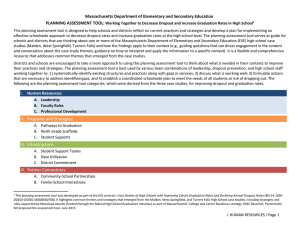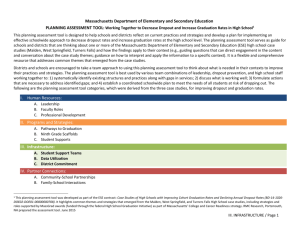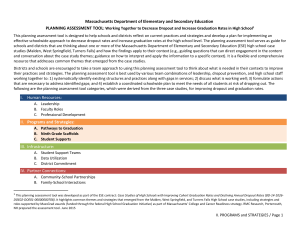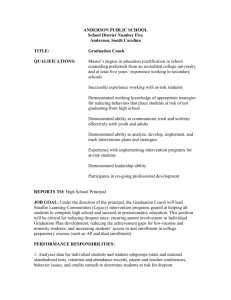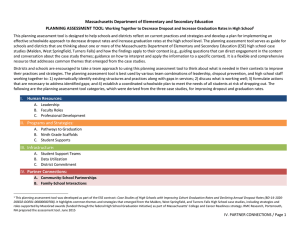2015 MA HSCaseStudyTool All
advertisement
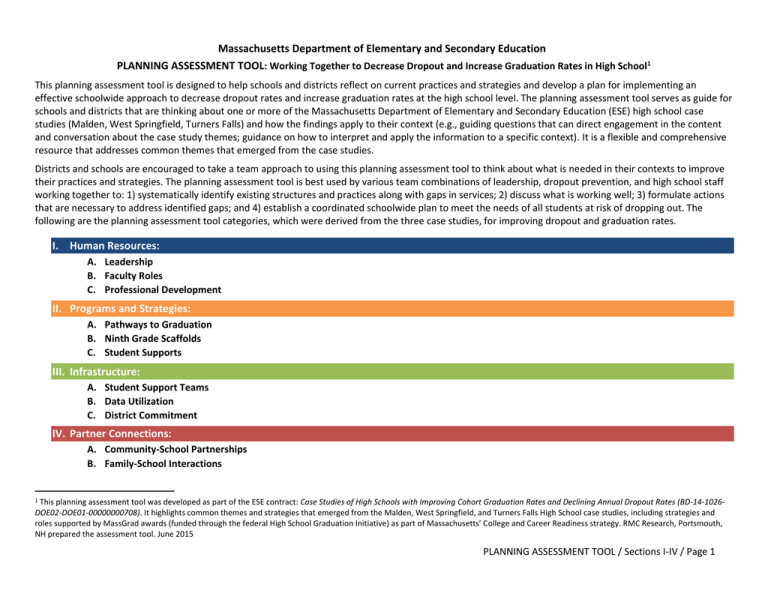
Massachusetts Department of Elementary and Secondary Education PLANNING ASSESSMENT TOOL: Working Together to Decrease Dropout and Increase Graduation Rates in High School1 This planning assessment tool is designed to help schools and districts reflect on current practices and strategies and develop a plan for implementing an effective schoolwide approach to decrease dropout rates and increase graduation rates at the high school level. The planning assessment tool serves as guide for schools and districts that are thinking about one or more of the Massachusetts Department of Elementary and Secondary Education (ESE) high school case studies (Malden, West Springfield, Turners Falls) and how the findings apply to their context (e.g., guiding questions that can direct engagement in the content and conversation about the case study themes; guidance on how to interpret and apply the information to a specific context). It is a flexible and comprehensive resource that addresses common themes that emerged from the case studies. Districts and schools are encouraged to take a team approach to using this planning assessment tool to think about what is needed in their contexts to improve their practices and strategies. The planning assessment tool is best used by various team combinations of leadership, dropout prevention, and high school staff working together to: 1) systematically identify existing structures and practices along with gaps in services; 2) discuss what is working well; 3) formulate actions that are necessary to address identified gaps; and 4) establish a coordinated schoolwide plan to meet the needs of all students at risk of dropping out. The following are the planning assessment tool categories, which were derived from the three case studies, for improving dropout and graduation rates. I. Human Resources: A. Leadership B. Faculty Roles C. Professional Development II. Programs and Strategies: A. Pathways to Graduation B. Ninth Grade Scaffolds C. Student Supports III. Infrastructure: A. Student Support Teams B. Data Utilization C. District Commitment IV. Partner Connections: A. Community-School Partnerships B. Family-School Interactions 1 This planning assessment tool was developed as part of the ESE contract: Case Studies of High Schools with Improving Cohort Graduation Rates and Declining Annual Dropout Rates (BD-14-1026DOE02-DOE01-00000000708). It highlights common themes and strategies that emerged from the Malden, West Springfield, and Turners Falls High School case studies, including strategies and roles supported by MassGrad awards (funded through the federal High School Graduation Initiative) as part of Massachusetts’ College and Career Readiness strategy. RMC Research, Portsmouth, NH prepared the assessment tool. June 2015 PLANNING ASSESSMENT TOOL / Sections I-IV / Page 1 RATE CURRENT STATUS SCHOOL STRUCTURES, PRACTICES, STRATEGIES Fully in Place Partially in Place Not Yet in Place DISCUSSION NOTES (WHAT’S IN PLACE?) I. HUMAN RESOURCES A. LEADERSHIP 1. The school principal has built a leadership team that has regular opportunities to deliberate the progress of at-risk students. 2. Programs that function as schools-withinschools, e.g., alternative schools and academies, have designated leaders who are on the school’s administrative team. 3. Leaders organize opportunities for teams to meet regularly to exchange information, evaluate progress, and make continuous improvements. Examples include outreach teams, data teams, and student referral/ support teams. 4. High school leaders have worked with middle school leaders to create transition activities to prepare middle school students for adjustment to the ninth grade. 5. School leaders support options beyond the regular course structure for struggling students to learn and attain academic credits, e.g., credit recovery courses, summer options. 6. The school principal sets a vision for educating ALL students that includes a rationale for focusing on reducing dropouts and increasing graduation rates. 7. School leaders set high expectations for the academic achievement of ALL students by maintaining rigor across pathways and programs. 8. Leadership sets challenging targets for dropout and graduation rates and reviews I. HUMAN RESOURCES / A. Leadership / Page 2 RATE CURRENT STATUS SCHOOL STRUCTURES, PRACTICES, STRATEGIES Fully in Place Partially in Place Not Yet in Place DISCUSSION NOTES (WHAT’S IN PLACE?) I. HUMAN RESOURCES A. LEADERSHIP progress against those targets. 9. The school principal sets high standards for all students and encourages faculty discussion of promoting academic rigor while supporting at-risk students. 10. District and school leaders encourage staff to use data (e.g., EWIS in Edwin Analytics) to identify at-risk students and set expectations for achievement. 11. Leaders recognize the importance of professional development for faculty and create opportunities for PLCs and other types of professional development. Leaders are actively involved in professional development. 12. Within the educator evaluation structure employed by the school, leaders have emphasized staff roles in creating a climate where struggling students can receive support. 13. School leaders have developed partnerships with leaders from the community and community service providers for the purpose of providing support services to at-risk students and their families. I. HUMAN RESOURCES / A. Leadership / Page 3 PLANS FOR NEXT STEPS I. HUMAN RESOURCES / A. LEADERSHIP 1. Review the discussion notes and identify common themes – Are there underlying needs (e.g., additional guidance staff) or common desired strategies (e.g., professional development in working with struggling students)? 2. Note the themes below and discuss priorities – Which approaches can be accomplished without additional resources and which require a longer-term strategy of reallocating resources? 3. Use that information to determine next steps – Consider a multi-prong strategy that will bring about some “quick wins” while you are working toward longer-term changes. I. HUMAN RESOURCES / A. Leadership / Page 4 RATE CURRENT STATUS SCHOOL STRUCTURES, PRACTICES, STRATEGIES Fully in Place Partially in Place Not Yet in Place DISCUSSION NOTES (WHAT’S IN PLACE?) I. HUMAN RESOURCES B. FACULTY ROLES 1. The school has adjustment counselors who address the behavioral/emotional needs of students so they can focus on academics. 2. The school has one or more staff members with a social work background who are able to address the range of needs of at-risk students from a holistic perspective. 3. The school has a formal program of mentoring, matching adults in the school and community with at-risk students to provide additional positive role models in students’ lives. 4. At least some staff have the ongoing role of making connections with students’ families and the community. 5. Some academic staff teach courses during the summer to support credit recovery and key academic transitions, especially from middle school to high school or from ninth to tenth grade. 6. Academic department chairpersons take on the role of supporting faculty members to work with students who are struggling, including coaching, developing learning plans, student placement, and/or assisting with diagnostic assessments. 7. Some members of academic departments take on the role of supporting and monitoring online credit recovery coursework, providing students with access to a highly qualified teacher in their subject I. HUMAN RESOURCES / B. Faculty Roles / Page 5 RATE CURRENT STATUS SCHOOL STRUCTURES, PRACTICES, STRATEGIES Fully in Place Partially in Place Not Yet in Place DISCUSSION NOTES (WHAT’S IN PLACE?) I. HUMAN RESOURCES B. FACULTY ROLES area. 8. All faculty are expected to build positive relationships with students to ensure that students feel well connected to the school. 9. Faculty who are directly involved in dropout prevention programs work collaboratively with their community counterparts (e.g., community youth resources). 10. Teaching faculty who are working in alternative programs also are considered members of the school’s academic departments (e.g., English language arts, science, history, mathematics) and participate in regular department meetings. 11. Guidance and other staff have explicit roles for easing the transition between middle and high school. 12. One or more staff members who focus on at-risk students have flexible schedules so that they are available during the school day to address immediately the concerns of specific students. The school has identified a welcoming and “safe” location (e.g., drop-in center, alternative learning center) where students can meet with designated staff during the school day, as needed. 13. The high school supports at least one graduation coach whose main focus is to reduce the dropout rate and help students move toward graduation. 14. The graduation coach conducts exit I. HUMAN RESOURCES / B. Faculty Roles / Page 6 RATE CURRENT STATUS SCHOOL STRUCTURES, PRACTICES, STRATEGIES Fully in Place Partially in Place Not Yet in Place DISCUSSION NOTES (WHAT’S IN PLACE?) I. HUMAN RESOURCES B. FACULTY ROLES interviews of students who have dropped out and reaches out to students who previously dropped out of school to encourage them and help develop a plan for return to the school. 15. Faculty or counseling staff are designated to work with students on the development of a four-year individualized plan for graduation (i.e., Individual Learning Plans/ILPs). 16. Faculty and other staff make home visits. I. HUMAN RESOURCES / B. Faculty Roles / Page 7 PLANS FOR NEXT STEPS I. HUMAN RESOURCES / B. FACULTY ROLES 1. Review the discussion notes and identify common themes – Are there underlying needs (e.g., additional guidance staff) or common desired strategies (e.g., professional development in working with struggling students)? 2. Note the themes below and discuss priorities – Which approaches can be accomplished without additional resources and which require a longer-term strategy of reallocating resources? 3. Use that information to determine next steps – Consider a multi-prong strategy that will bring about some “quick wins” while you are working toward longer-term changes. I. HUMAN RESOURCES / B. Faculty Roles / Page 8 RATE CURRENT STATUS SCHOOL STRUCTURES, PRACTICES, STRATEGIES Fully in Place Partially in Place DISCUSSION NOTES (WHAT’S IN PLACE?) Not Yet in Place I. HUMAN RESOURCES C. PROFESSIONAL DEVELOPMENT 1. School leaders, faculty, and staff who work with students at risk of dropping out receive professional development related to dropout prevention strategies (e.g., differentiated instruction, assessment, adolescent development, and helping students who have experienced trauma and face multiple obstacles such as depression and alcohol and drug abuse). 2. Counselors provide professional development for staff to help them understand students’ circumstances outside the school and learn to provide constructive responses to students’ negative classroom behaviors. 3. To extend the dialogue on supporting youth, community members are invited to participate in those school professional development opportunities that are of mutual interest (e.g., mental health issues of at-risk students). 4. Staff teams, such as ninth grade academy or alternative school faculty and counselors, receive professional development and training together as a group. I. HUMAN RESOURCES / C. Professional Development / Page 9 RATE CURRENT STATUS SCHOOL STRUCTURES, PRACTICES, STRATEGIES Fully in Place Partially in Place DISCUSSION NOTES (WHAT’S IN PLACE?) Not Yet in Place I. HUMAN RESOURCES C. PROFESSIONAL DEVELOPMENT 5. For schools with courses focused on helping at-risk students build selfgovernance skills (e.g., Reconnecting Youth), the school provides specific training to carefully selected, dedicated staff members. 6. The principal and other school leaders provide follow up support to reinforce staff training and to model/demonstrate effective practices. 7. The school principal or guidance staff provide feedback about teachers’ implementation of strategies to support students at-risk of dropping out. 8. The school principal encourages collaboration among teaching and guidance staff for the purpose of learning about and improving dropout prevention programs and services. 9. Professional learning communities provide school teams (e.g., outreach, support, data, ninth grade academy teams) with time to plan, review practices, analyze student data, and revise teaching strategies to support students at risk for dropping out. 10. Academic department PLCs include staff members with dedicated dropout prevention and alternative school roles. 11. School provides flexibility in scheduling to support dedicated time for PLCs/team meetings. I. HUMAN RESOURCES / C. Professional Development / Page 10 RATE CURRENT STATUS SCHOOL STRUCTURES, PRACTICES, STRATEGIES Fully in Place Partially in Place DISCUSSION NOTES (WHAT’S IN PLACE?) Not Yet in Place I. HUMAN RESOURCES C. PROFESSIONAL DEVELOPMENT 12. Adjustment and guidance counselors meet and consult with teaching faculty on a regular basis, to specifically enable teachers to address both the socialemotional and academic needs of students. 13. Department chairs or other academic faculty support teachers through coaching or other types of consultation. 14. Teachers have opportunities to observe and practice effective strategies, with feedback from knowledgeable professionals, including other teachers and coaches. 15. Staff has access to professional expertise (e.g., social workers, psychologists, and other mental health providers) for consultation and referral services related to helping students at risk of dropping out. I. HUMAN RESOURCES / C. Professional Development / Page 11 PLANS FOR NEXT STEPS I. HUMAN RESOURCES / C. PROFESSIONAL DEVELOPMENT 1. Review the discussion notes and identify common themes – Are there underlying needs (e.g., additional guidance staff) or common desired strategies (e.g., professional development in working with struggling students)? 2. Note the themes below and discuss priorities – Which approaches can be accomplished without additional resources and which require a longer-term strategy of reallocating resources? 3. Use that information to determine next steps – Consider a multi-prong strategy that will bring about some “quick wins” while you are working toward longer-term changes. I. HUMAN RESOURCES / C. Professional Development / Page 12 RATE CURRENT STATUS SCHOOL STRUCTURES, PRACTICES, STRATEGIES Fully in Place Partially in Place DISCUSSION NOTES (WHAT’S IN PLACE?) Not Yet in Place II. PROGRAMS AND STRATEGIES A. PATHWAYS TO GRADUATION 1. Multiple pathways for reaching high school graduation are made available to students matched to their needs or risk factors for dropping out (e.g., poor attendance, low academic achievement, family crises, social-emotional or mental health issues, special learning needs). 2. The school provides an appropriate program option for former students who had dropped out and have returned to reengage in the school. 3. Students have multiple options for attaining credits needed to graduate (e.g., credit recovery courses, dual enrollment options, summer school programs, evening courses). 4. Dual enrollment programs are offered to ALL high school students, not just for high achieving students, in close partnership with institutions of higher learning in the community. 5. Technical and vocational programs are available to ALL students, including those at risk of dropping out (e.g., through regional programs and business partnerships). 6. Alternative programs maintain the same high standards for academic achievement and graduation as the typical high school program. 7. The courses offered via credit recovery and other alternative course programs are II. PROGRAMS AND STRATEGIES / A. Pathways to Graduation / Page 13 RATE CURRENT STATUS SCHOOL STRUCTURES, PRACTICES, STRATEGIES Fully in Place Partially in Place DISCUSSION NOTES (WHAT’S IN PLACE?) Not Yet in Place II. PROGRAMS AND STRATEGIES A. PATHWAYS TO GRADUATION high quality and set a foundation for subsequent courses. 8. Academic department faculty certified in the relevant subject areas teach credit recovery courses. II. PROGRAMS AND STRATEGIES / A. Pathways to Graduation / Page 14 PLANS FOR NEXT STEPS II. PROGRAMS AND STRATEGIES / A. PATHWAYS TO GRADUATION 4. Review the discussion notes and identify common themes – Are there underlying needs (e.g., additional guidance staff) or common desired strategies (e.g., professional development in working with struggling students)? 5. Note the themes below and discuss priorities – Which approaches can be accomplished without additional resources and which require a longer-term strategy of reallocating resources? 6. Use that information to determine next steps – Consider a multi-prong strategy that will bring about some “quick wins” while you are working toward longer-term changes. II. PROGRAMS AND STRATEGIES / A. Pathways to Graduation / Page 15 RATE CURRENT STATUS SCHOOL STRUCTURES, PRACTICES, STRATEGIES Fully in Place Partially in Place DISCUSSION NOTES (WHAT’S IN PLACE?) Not Yet in Place II. PROGRAMS AND STRATEGIES B. NINTH GRADE SCAFFOLDS 1. The school has a structure to meet the distinctive academic and social needs of ninth grade students (e.g., a ninth grade academy or other comparable program). 2. The school has teaching and counseling staff dedicated to working as a cohesive team with ninth grade students. 3. Ninth grade program leadership is in place. The program has its own administrator or other faculty member who is charged with directing and supervising the program. 4. Guidance, adjustment, and other counseling staff serve as collaborative members of the ninth grade team. 5. The ninth grade program team shares a common prep time to discuss student needs, review and revise practices, analyze student data, and plan instruction. 6. Students in separate ninth grade programs participate in all activities held as a regular part of the school day (e.g., all-school assemblies, student governance meetings, elective programs) as well as extracurricular activities (e.g., clubs, sports, servicelearning, social events). 7. The high school has a program or strategy in place to ease the transition for middle school students and familiarize students and their families with the high school experience (e.g., home visits and phone calls, middle school meetings, high school II. PROGRAMS AND STRATEGIES / B. Ninth Grade Scaffolds / Page 16 RATE CURRENT STATUS SCHOOL STRUCTURES, PRACTICES, STRATEGIES Fully in Place Partially in Place DISCUSSION NOTES (WHAT’S IN PLACE?) Not Yet in Place II. PROGRAMS AND STRATEGIES B. NINTH GRADE SCAFFOLDS open houses and tours, community events). 8. High school and middle school counselors meet to review the backgrounds of the eighth grade students to identify those who may be at risk as high school freshmen. 9. At the beginning of the year, ninth grade counselors meet individually with entering freshmen students to review college and career options. II. PROGRAMS AND STRATEGIES / B. Ninth Grade Scaffolds / Page 17 PLANS FOR NEXT STEPS II. PROGRAMS AND STRATEGIES / B. NINTH GRADE SCAFFOLDS 1. Review the discussion notes and identify common themes – Are there underlying needs (e.g., additional guidance staff) or common desired strategies (e.g., professional development in working with struggling students)? 2. Note the themes below and discuss priorities – Which approaches can be accomplished without additional resources and which require a longer-term strategy of reallocating resources? 3. Use that information to determine next steps – Consider a multi-prong strategy that will bring about some “quick wins” while you are working toward longer-term changes. II. PROGRAMS AND STRATEGIES / B. Ninth Grade Scaffolds / Page 18 RATE CURRENT STATUS SCHOOL STRUCTURES, PRACTICES, STRATEGIES Fully in Place Partially in Place DISCUSSION NOTES (WHAT’S IN PLACE?) Not Yet in Place II. PROGRAMS AND STRATEGIES C. STUDENT SUPPORTS 1. There is a clear referral process in place so that academic teachers can easily refer students who need additional socialemotional and mental health support to counseling and/or support services staff. 2. Counseling and support services are responsive to the real lives of at-risk students (e.g., work and family responsibilities). Services are coordinated to accommodate students’ school and work schedules when necessary. 3. Guidance and other social-emotional and behavioral support services for at-risk students are provided within the high school setting (e.g., adjustment counselors, graduation coach, restorative practices, or other behavioral support programs). 4. The high school brings in external providers to deliver student services when necessary (e.g., individual or group counseling). 5. Students at risk of dropping out have various opportunities to build positive connections with school staff and peers (e.g., Reconnecting Youth, conflict resolution practices, elective courses, sports and arts pursuits, service-learning projects). II. PROGRAMS AND STRATEGIES / C. Student Supports / Page 19 RATE CURRENT STATUS SCHOOL STRUCTURES, PRACTICES, STRATEGIES Fully in Place Partially in Place DISCUSSION NOTES (WHAT’S IN PLACE?) Not Yet in Place II. PROGRAMS AND STRATEGIES C. STUDENT SUPPORTS 6. Faculty and staff are proactive in reaching out to at-risk students to build close relationships (e.g., phone calls, home visits, sports, restorative practices). 7. Faculty and staff provide encouragement and support to help students create a strong peer community at the school (e.g., through learning to interact and communicate with each other in positive and open ways). 8. Students in self-contained alternative school programs, whether on- or off-site, are made to feel that they are part of the high school community and have access to all high school activities (e.g., clubs, sports, service-learning, social events). II. PROGRAMS AND STRATEGIES / C. Student Supports / Page 20 PLANS FOR NEXT STEPS II. PROGRAMS AND STRATEGIES / C. STUDENT SUPPORTS 1. Review the discussion notes and identify common themes – Are there underlying needs (e.g., additional guidance staff) or common desired strategies (e.g., professional development in working with struggling students)? 2. Note the themes below and discuss priorities – Which approaches can be accomplished without additional resources and which require a longer-term strategy of reallocating resources? 3. Use that information to determine next steps – Consider a multi-prong strategy that will bring about some “quick wins” while you are working toward longer-term changes. II. PROGRAMS AND STRATEGIES / C. Student Supports / Page 21 RATE CURRENT STATUS SCHOOL STRUCTURES, PRACTICES, STRATEGIES Fully in Place Partially in Place Not Yet in Place DISCUSSION NOTES (WHAT’S IN PLACE?) III. INFRASTRUCTURE A. STUDENT SUPPORT TEAMS 1. A student support team type structure is in place for the school’s adults to communicate frequently and regularly about their reasoning and decisions regarding individual students, and to make sure they are doing what is best for each student. 2. The student support team makes decisions about planning interventions and securing additional services for individual students. 3. The school’s student support team is empowered to apply academic interventions in a flexible manner (e.g., double doses of academic courses, credit recovery). 4. The student support team has flexibility that allows them to address individual student crises immediately. 5. Counselors are an integral part of academic and support teams working with students at risk for dropping out of school and provide intense individualized services to support students and families. 6. A process for recording and tracking academic and counseling services provided to at-risk student has been established to coordinate the timely delivery of supports and avoid overlap and duplication. 7. The student support team meets as a group with a student or family to send a unified message. III. INFRASTRUCTURE / A. Student Support Teams / Page 22 PLANS FOR NEXT STEPS III. INFRASTRUCTURE / A. STUDENT SUPPORT TEAMS 1. Review the discussion notes and identify common themes – Are there underlying needs (e.g., additional guidance staff) or common desired strategies (e.g., professional development in working with struggling students)? 2. Note the themes below and discuss priorities – Which approaches can be accomplished without additional resources and which require a longer-term strategy of reallocating resources? 3. Use that information to determine next steps – Consider a multi-prong strategy that will bring about some “quick wins” while you are working toward longer-term changes. III. INFRASTRUCTURE / A. Student Support Teams / Page 23 RATE CURRENT STATUS SCHOOL STRUCTURES, PRACTICES, STRATEGIES Fully in Place Partially in Place Not Yet in Place DISCUSSION NOTES (What’s in Place?) III. INFRASTRUCTURE B. DATA UTILIZATION 1. The school has a designated data team (or other group) that examines multiple data sources on a routine basis (e.g., tracking early warning and attendance data, reviewing grades and discipline data, and reviewing experiences of students and recent graduates through the state data system) to stimulate discussions about the scope and nature of dropout patterns at the school (e.g., credit attainment, obstacles to graduation) and generate program improvements to support student graduation success. 2. Data tools (e.g., Early Warning Indicator System) are used to identify and monitor progress of at-risk ninth graders. 3. The high school has a designated data team (or other group) to monitor and review early warning indicators, maintain a watch-list of at-risk students, and inform other teams and staff. 4. The data team (or other designated group) recommends or establishes appropriate interventions for students at key transitions (e.g., students moving from one grade to the next, nearing graduation). III. INFRASTRUCTURE / B. Data Utilization / Page 24 RATE CURRENT STATUS SCHOOL STRUCTURES, PRACTICES, STRATEGIES Fully in Place Partially in Place Not Yet in Place DISCUSSION NOTES (What’s in Place?) III. INFRASTRUCTURE B. DATA UTILIZATION 5. Data team staff meet with teachers and counselors working with students at risk of dropping out to review, analyze, and use data to plan and coordinate instruction and behavioral or other support strategies for students. III. INFRASTRUCTURE / B. Data Utilization / Page 25 PLANS FOR NEXT STEPS III. INFRASTRUCTURE / B. DATA UTILIZATION 1. Review the discussion notes and identify common themes – Are there underlying needs (e.g., additional guidance staff) or common desired strategies (e.g., professional development in working with struggling students)? 2. Note the themes below and discuss priorities – Which approaches can be accomplished without additional resources and which require a longer-term strategy of reallocating resources? 3. Use that information to determine next steps – Consider a multi-prong strategy that will bring about some “quick wins” while you are working toward longer-term changes. III. INFRASTRUCTURE / B. Data Utilization / Page 26 RATE CURRENT STATUS SCHOOL STRUCTURES, PRACTICES, STRATEGIES Fully in Place Partially in Place Not Yet in Place DISCUSSION NOTES (WHAT’S IN PLACE?) III. INFRASTRUCTURE C. DISTRICT COMMITMENT 1. The district develops and shares dropout prevention policies with all high school administrators, specialists, and relevant teaching staff. 2. District leaders collaborate with the high school to establish challenging targets for student achievement and dropout/graduation rates and review each school’s progress against those targets. 3. District leaders communicate the importance of using researchbased practices for preventing students from dropping out and for recovering students who are out of school. 4. District staff are available to provide the high school with expertise, guidance, and training on dropout prevention efforts (e.g., integrating academics and college and career readiness options; establishing transition programs, summer bridge programs, and/or summer institutes; prevention and recuperative strategies for students who are off-track to graduation). 5. The district communicates dropout prevention policies to parents of students who are at risk of dropping out of school. III. INFRASTRUCTURE / C. District Commitment / Page 27 RATE CURRENT STATUS SCHOOL STRUCTURES, PRACTICES, STRATEGIES Fully in Place Partially in Place Not Yet in Place DISCUSSION NOTES (WHAT’S IN PLACE?) III. INFRASTRUCTURE C. DISTRICT COMMITMENT 6. District leadership has identified and pursued local, state, and federal grant monies to support implementation of recommended practices in a coordinated dropout prevention and recovery program (e.g., professional development and staff training). 7. The district has established partnerships with community-based program providers and other agencies such as social services, welfare, mental health, and law enforcement, to implement behavioral and social skills programs. 8. The district has developed partnerships with local postsecondary institutions to host prospective student visits and workshops on completing postsecondary and financial aid applications. 9. The district has reached out to partner with local industries and businesses to create new avenues for introducing at-risk students to career and work-study options. 10. The district has been proactive in collaborating with community agencies and businesses to identify local resources (e.g., mentors, service-learning projects, work experiences) to help the high school provide community engagement opportunities to students who are at risk of dropping out. III. INFRASTRUCTURE / C. District Commitment / Page 28 PLANS FOR NEXT STEPS III. INFRASTRUCTURE / DISTRICT COMMITMENT 1. Review the discussion notes and identify common themes – Are there underlying needs (e.g., additional guidance staff) or common desired strategies (e.g., professional development in working with struggling students)? 2. Note the themes below and discuss priorities – Which approaches can be accomplished without additional resources and which require a longer-term strategy of reallocating resources? 3. Use that information to determine next steps – Consider a multi-prong strategy that will bring about some “quick wins” while you are working toward longer-term changes. III. INFRASTRUCTURE / C. District Commitment / Page 29 RATE CURRENT STATUS SCHOOL STRUCTURES, PRACTICES, STRATEGIES Fully in Place Partially in Place DISCUSSION NOTES Not Yet in Place (WHAT’S IN PLACE?) IV. PARTNER CONNECTIONS A. COMMUNITY-SCHOOL PARTNERSHIPS 1. The high school has established partnerships with community agencies that provide support for its programs and staff focused on dropout prevention. 2. The high school has developed partnerships with local postsecondary institutions to provide students with college and career readiness opportunities beyond that offered by the school (e.g., dual enrollment programs, campus visits, career guidance). 3. The high school has identified and formed partnerships with local businesses to provide students with mentoring, internships, or work-based learning opportunities beyond those offered by the school. 4. School leaders maintain ongoing communication with community partners about the school’s goals and needs. 5. All school staff are knowledgeable about the school’s partnerships, kept informed about services offered, and involved in the planning and integration of those services into the school’s programs focused on dropout prevention. 6. Community partners provide human resources that can remove burden from the school (e.g., in-kind services such as consulting, staff coaching and training, school and community professional development). IV. PARTNER CONNECTIONS / Community-School Partnerships / Page 30 RATE CURRENT STATUS SCHOOL STRUCTURES, PRACTICES, STRATEGIES Fully in Place Partially in Place DISCUSSION NOTES Not Yet in Place (WHAT’S IN PLACE?) IV. PARTNER CONNECTIONS A. COMMUNITY-SCHOOL PARTNERSHIPS 7. Community partners assist the school’s leadership with identifying potential funding streams to support and sustain the high school’s dropout prevention initiatives. 8. Community partnerships help the high school identify, recruit, and train adult advocates from the community who are invested in the success of students at risk of dropping out. 9. Community partnership activities outside of the school day provide students with additional opportunities to extend their learning and engagement (e.g., servicelearning, enrichment projects, team building experiences). IV. PARTNER CONNECTIONS / Community-School Partnerships / Page 31 PLANS FOR NEXT STEPS IV. PARTNER CONNECTIONS / A. COMMUNITY-SCHOOL PARTNERSHIPS 7. Review the discussion notes and identify common themes – Are there underlying needs (e.g., additional guidance staff) or common desired strategies (e.g., professional development in working with struggling students)? 8. Note the themes below and discuss priorities – Which approaches can be accomplished without additional resources and which require a longer-term strategy of reallocating resources? 9. Use that information to determine next steps – Consider a multi-prong strategy that will bring about some “quick wins” while you are working toward longer-term changes. IV. PARTNER CONNECTIONS / Community-School Partnerships / Page 32 RATE CURRENT STATUS SCHOOL STRUCTURES, PRACTICES, STRATEGIES Fully in Place Partially in Place DISCUSSION NOTES Not Yet in Place (WHAT’S IN PLACE?) IV. PARTNER CONNECTIONS B. FAMILY-SCHOOL INTERACTIONS 1. The high school offers multiple formats and venues for parents and families to build relationships with teachers and counselors as well as receive information about programs and services available to students who are at risk of dropping out (e.g., school orientations, community events, morning or evening gatherings, weekend school projects). 2. Staff continuously reach out to connect with all parents and families of at-risk students (e.g., in their homes or community locations, throughout the school year, and over the summer if indicated). 3. High school staff plan periodic events to celebrate student success with parents and extended families. 4. School staff view parents as partners in their work with students and are sensitive and responsive to family backgrounds and circumstances. 5. School staff share with all parents the school’s expectation of success for ALL students, make explicit how they are helping students move forward to graduation, and discuss student successes and learning needs. IV. PARTNER CONNECTIONS / B. Family-School Interactions / Page 33 RATE CURRENT STATUS SCHOOL STRUCTURES, PRACTICES, STRATEGIES Fully in Place Partially in Place DISCUSSION NOTES Not Yet in Place (WHAT’S IN PLACE?) IV. PARTNER CONNECTIONS B. FAMILY-SCHOOL INTERACTIONS 6. For at-risk students who receive multiple services, parents have a single point of contact at the school who communicates a coordinated response from the team(s) working with their students. IV. PARTNER CONNECTIONS / B. Family-School Interactions / Page 34 PLANS FOR NEXT STEPS IV. PARTNER CONNECTIONS / B. FAMILY-SCHOOL INTERACTIONS 1. Review the discussion notes and identify common themes – Are there underlying needs (e.g., additional guidance staff) or common desired strategies (e.g., professional development in working with struggling students)? 2. Note the themes below and discuss priorities – Which approaches can be accomplished without additional resources and which require a longer-term strategy of reallocating resources? 3. Use that information to determine next steps – Consider a multi-prong strategy that will bring about some “quick wins” while you are working toward longer-term changes. IV. PARTNER CONNECTIONS / B. Family-School Interactions / Page 35
